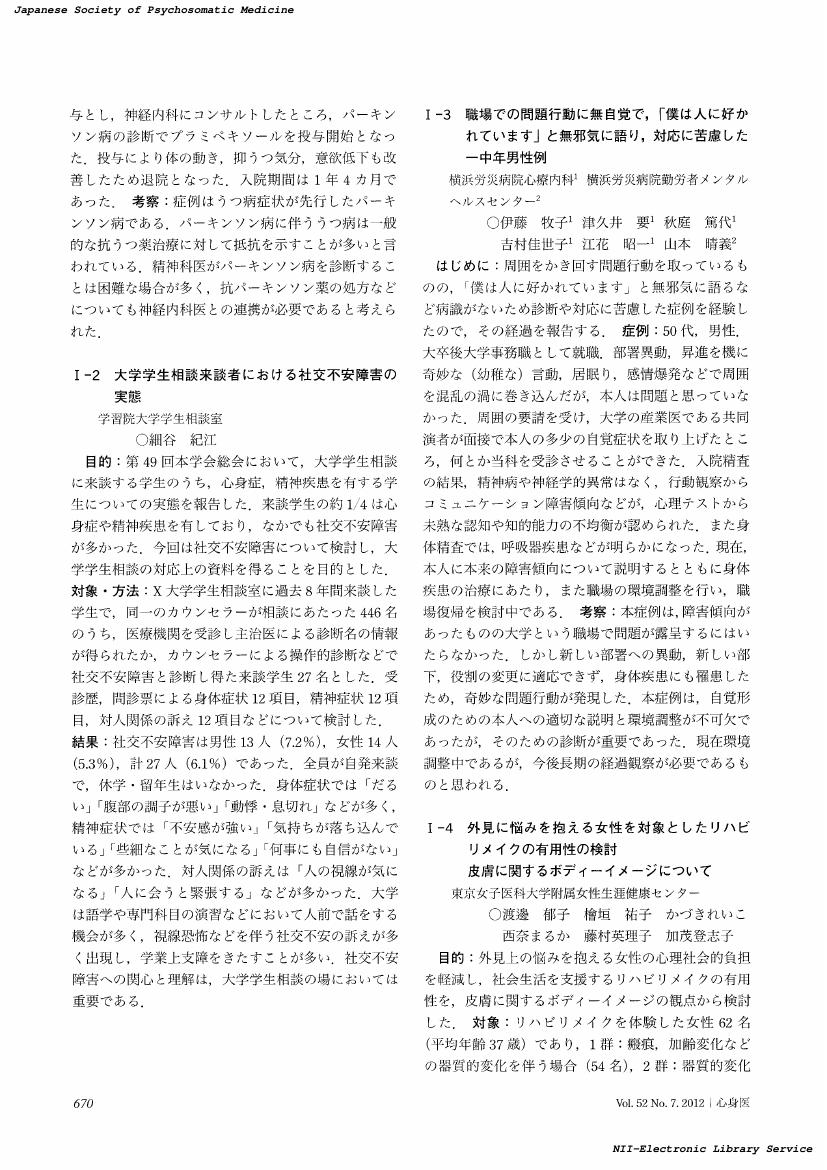- 著者
- 津久井 要 山本 晴義
- 出版者
- 日経BP社
- 雑誌
- 日経メディカル (ISSN:03851699)
- 巻号頁・発行日
- no.384, pp.133-136, 1999-11
近年,分裂病やうつ病の軽症化が指摘されるようになって久しい。1966年に軽症うつ病を本邦で最初に指摘した平沢1)は,その特徴を,受診時における症状の前景には身体症状(身体的愁訴)がみられ,うつ病特有の精神症状は背後に隠れている場合が多い入院治療を必要とするほどは重症化せず,外来治療に終始する病前性格としてはメランコリー親和型性格が多い(メランコリー親和型…
2 0 0 0 若年勤労者の出社困難症 : その現状と対応の限界
- 著者
- 津久井 要 江花 昭一 山本 晴義 西川 哲男 川原 健資 天保 英明 境 洋二郎 秋庭 篤代
- 雑誌
- 日本災害医学会会誌 = The journal of Japan Accident Medical Association (ISSN:0386975X)
- 巻号頁・発行日
- vol.47, no.4, pp.219-224, 1999-04-01
1 0 0 0 OA 絶食療法の脳波学的研究 : 特に脳波パワースペクトルの変動について
- 著者
- 山本 晴義
- 出版者
- 一般社団法人 日本心身医学会
- 雑誌
- 心身医学 (ISSN:03850307)
- 巻号頁・発行日
- vol.20, no.4, pp.325-335, 1980-08-01 (Released:2017-08-01)
- 被引用文献数
- 3
In order to ascertain whether or not the therapeutic mechanism of fasting therapy lies within the changes occurring within the central nervous system, an electroencephalogram was recorded before, during and after fasting therapy. This therapy consisted of complete fasting for 10 days with subsequent resumption of regular meals for 6 days. EEG data was passed to the computer using a Sanei Model Signal Processor 7TO7. The resultant power spectrum covered the frequency range from D.C. to 25Hz with 0.195Hz resolution. Such spectra were obtained from the left occipital region at various stages of the therapy. During the experiment, patients were awake with their eyes closed. Changes in EEG power spectra through therapy were examined by peak frequency and percent energy. The average peak frequency of forty patients was 10.3Hz before fasting, but it decreased to 9.5Hz following 10-day fasting. After the recovery phase, it again increased to 10.1Hz. This decrease in peak frequency through fasting correlates statistically with a decrease in blood sugar level (r=+0.36,P<0.05). Subsequently, the percent energy was obtained at a frequency range of 4 to 20Hz. This range was divided into three parts : 'theta' with a range of 4 to 8Hz, 'alpha' with a range of 8 to 13Hz, and 'beta' ranging from 13 to 20Hz. The average percent energy of 40 patients for 'theta', 'alpha' and 'beta' was, respectively, 16%, 63%, 21% before fasting, 18%, 65%, 17% after 10-day fasting, and 15%, 70%, 15% after the recovery phase. The percent energy of 'alpha' after fasting therapy was significantly higher than that of the pre-fasting stage (P<0.001), while the percent energy of 'beta' after fasting therapy was significantly lower than that of the pre-fasting stage (P<0.001). The significantly higher percent energy of alpha waves indicates the stable psychological state of the post-fasting period. On the other hand, the beta waves decreased during the fasting period, and they did not reappear again in the same fashion even after the recovery phase. As these waves indicate psychological conditions of anxiety, tension and irritation, their decrease may imply objectively that fasting can ease these symptoms. These neurophysiological findings imply that Altered States of Consciousness, or ASC, have much to do with the psychotherapeutic effect. Since ASC can be attained easily through fasting, it is suggested that fasting therapy is an effective somatopsychic approach.
- 著者
- 江花 昭一 山本 晴義 秋庭 篤代 吉村 佳世子 境 洋二郎 津久井 はるみ 天保 英明 川原 健資 津久井 要
- 出版者
- 一般社団法人 日本心身医学会
- 雑誌
- 心身医学 (ISSN:03850307)
- 巻号頁・発行日
- vol.40, no.2, pp.111-117, 2000
- 参考文献数
- 14
- 被引用文献数
- 1
心身医療は問題や疾患の同定から始めproblem talkを行うのが通例であり, 問題に焦点を当てずsolution talkを行う解決志向アプローチとは必ずしも整合的でない.また, 解決志向アプローチは多忙な臨床現場で十分な効果が発揮できる方法であろうか.今回われわれは, 2症例の検討を通して, これら2点の調査を行った.その結果, 多忙な日常臨床においても, 治療関係のタイプを吟味する, 問題を解決の資源として活用する, 可能性を引き出す対話を行う, 定型的質問を使用するなどの技法が実行可能かつ有効であった.解決志向アプローチは, 心身医療に組み込んでも, 解決を速やかにもたらし定着させる有用な方法であると考えられた.
- 著者
- 伊藤 牧子 津久井 要 秋庭 篤代 吉村 佳世子 江花 昭一 山本 晴義
- 出版者
- 一般社団法人 日本心身医学会
- 雑誌
- 心身医学 (ISSN:03850307)
- 巻号頁・発行日
- vol.52, no.7, pp.670, 2012-07-01 (Released:2017-08-01)
- 著者
- 川原 健資 山本 晴義 江花 昭一 津久井 要 天保 英明 境 洋二郎 秋庭 篤代
- 出版者
- 一般社団法人日本心身医学会
- 雑誌
- 心身医学 (ISSN:03850307)
- 巻号頁・発行日
- vol.39, 1999-05-01
